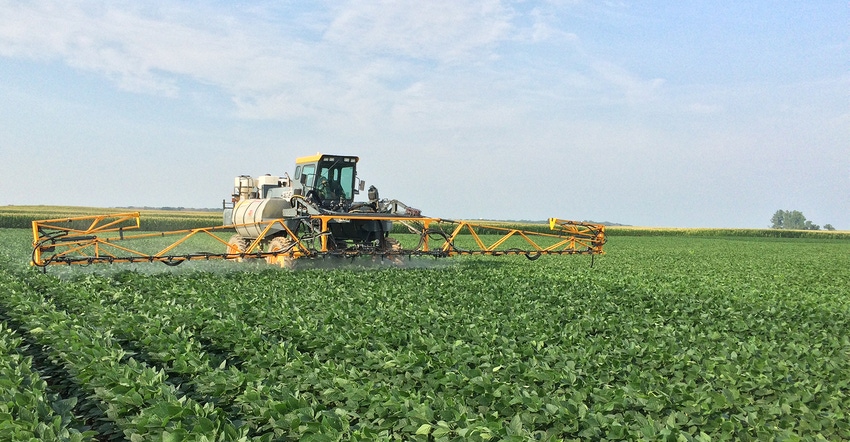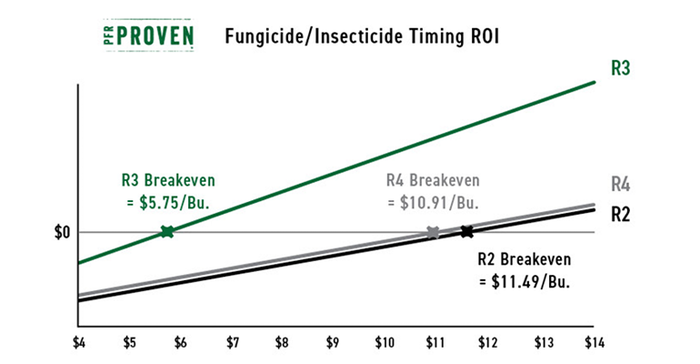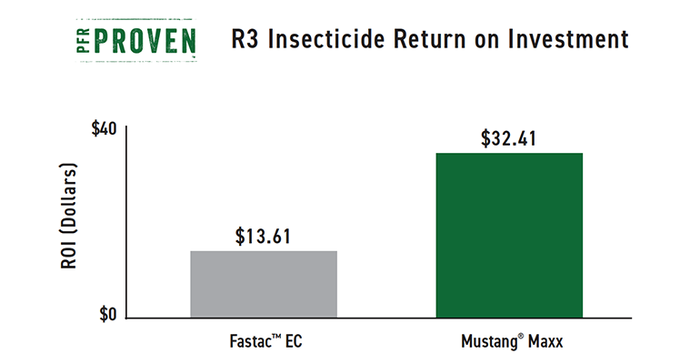August 1, 2018

Sponsored Content
Each year, farmers make many decisions regarding the use of fungicides and insecticides– all the while hoping their applications end up being profitable. Products, timing, and system of applications are just a few of the factors to be considered. In light of this, Beck’s Practical Farm Research (PFR)® team has studied both fungicide and insecticide applications for many years to determine the best approach, timing and products that farmers can use on their fields to achieve the best yields and return on investment (ROI).
Fungicide applications are often made to prevent disease from entering soybean fields. Unfortunately, once a disease has set in, it’s likely that yield has already been lost, but the amount can be unclear. University and industry research alike has shown a synergistic effect with the combined use of fungicides and insecticides; however, specific yield gains will vary from one year to the next. In a meta-analysis done at the University of Wisconsin, a 0.5 to 1.0 Bu./A. advantage was noted with the addition of an insecticide in various Midwestern states. Additionally, Beck’s PFR knows that the damage caused by insects can further promote diseases and therefore justifies the combined application.
Many soybean fungicides are recommended at an R3 growth stage application. The R3 growth stage in soybeans is identified by having at least one pod that is 3/16 in. long at one of the four uppermost nodes. But why is an R3 application important? Since R3 is the start of pod development, it’s also the best time to control diseases and insects. Because a majority of yield (about 60 percent) comes from nodes 7-13, an R3 application would add protection to those nodes, which might explain the positive yield response. Even in the absence of disease pressure, fungicides can also offer consistent yield gains. Beck’s seven-year PFR data has shown a $17/A. ROI advantage from an R3 application of a fungicide and insecticide and a breakeven of $5.75/Bu. If soybeans are sprayed at R2, the per bushel price to breakeven rises to $11.50/Bu. By missing the application by a single growth stage (R4), the breakeven rises to $10.91/Bu. Essentially, missing the R3 timing results in a cost of roughly $5/Bu.

The fungicides that were marked as PFR Proven in 2016 at the R3 growth stage were Priaxor®, Stratego® YLD, and Preemptor™ SC. Priaxor is a combination of a strobilurin and carboxamide fungicide. At a 4 oz. rate, a yield advantage of 3. Bu./A. has been observed over four years. Stratego YLD is a combination of a triazole and a strobilurin that, when applied at a rate of 4 oz./A, has shown a yield advantage average of 4.4 Bu./A. over four years. Preemptor SC is a combination of a strobilurin and triazole fungicide. It has shown a yield advantage of 3.8 Bu./A. when a 5 oz./A. rate was applied at R3. Strobilurin fungicides offer additional benefits in soybeans other than just disease control/suppression too, such as increased stress tolerance, greater water use efficiency, improved C02 assimilation, and delayed plant senescence. These proven fungicides offer broad-spectrum, long-lasting disease control and higher yield potential.
If you’re already planning to spray a fungicide, it’s easy and inexpensive to add in an insecticide as well. This is especially true when you consider late-season foliar insecticides have shown the potential to provide collaborative effects when applied with fungicides. For this reason, many farmers choose to apply this combination of products, while others may choose to apply insecticides based off of economic thresholds. Although Beck’s PFR team has focused on the control of insects and the use of insecticides, we know from previous research that a combined application of an insecticide and fungicide can result in a synergistic or net greater effect. In other words, 2 + 2 does not equal 4 in this instance, but more like 5 or greater with the combined application of both products. Fastac™ EC and Mustang® Maxx are two insecticides that have been marked as PFR Proven after three and seven years of studies, respectively.
Mustang Maxx has superior knockdown capabilities, but offers little to no residual activity. When insect pressure is high and you need a fast knockdown of troublesome pests, its pyrethroid chemistry is the best option. When insect pressure is not extreme and you need a tank mix partner for a fungicide application, an insecticide with some sort of residual, like Fastac EC, is a more ideal choice.
Fastac EC has residual and repellent action, so it is a good tank mix partner in a planned fungicide application at the R3 growth stage. The residual aspect this insecticide offers provides consistent results when planning to apply it around a particular growth stage.

When planning to make applications to your fields during the growing season, whether preventative or curative, consider making one pass by combining your fungicide and insecticide.
Beck’s PFR team continuously works to evaluate new products and practices that can make an impact on your farm. To view the results of the studies or others, visit www.beckshybrids.com/pfresearch.
Practical Farm Research (PFR)® and PFR Proven™ are trademarks of Beck’s Superior Hybrids, Inc. Priaxor® and Fastac™ are registered trademarks of BASF. Stratego® is a registered trademark of Bayer. Preemptor™ and Mustang® are trademarks of FMC Corporation.
About the Author(s)
You May Also Like




